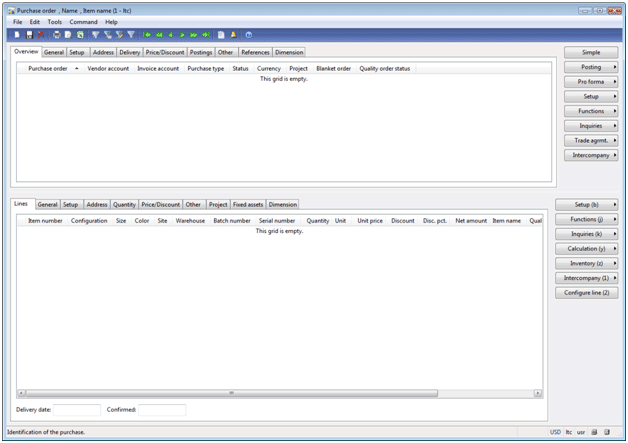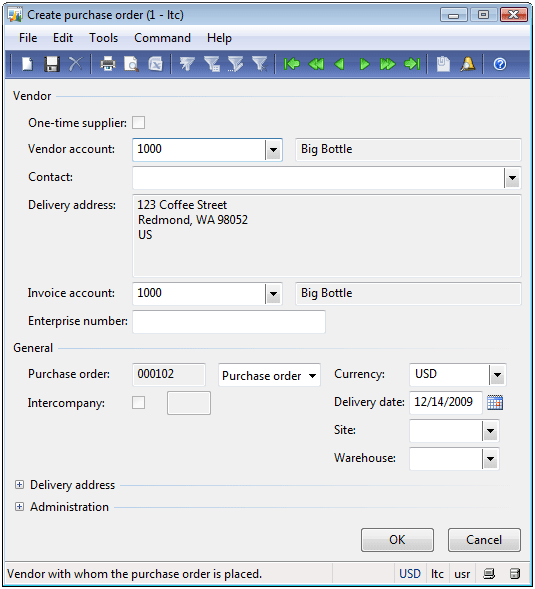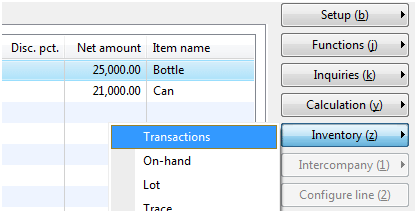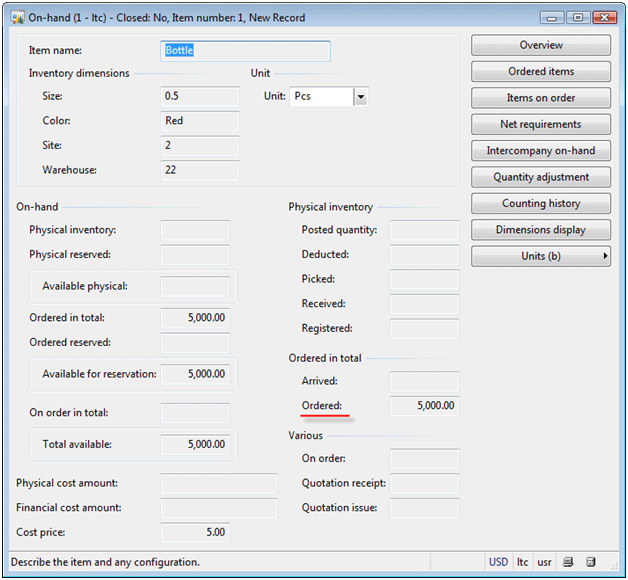Create purchase order
In this Microsoft Dynamics AX training lesson, we will create a purchase order, discuss its main fields, and understand how the user can control the purchase order process in Microsoft Dynamics AX.
We will use the following information from the Trade and Logistics 6 (Purchase business process 1 training lesson:
- Company purchases 5,000 Bottles Red 0.5 and 3,000 Cans Standard Black
- Company vendor is the Big bottle company
- For the Bottle item, we will set up the purchase price to 5$, its cost price to 5$, and its sales price to 9$.
- For the Can item, we will set up the purchase price to 7$, the cost price to 7$, and the sales price to 12$.
- Go to Inventory management > Common Forms > Item details. Select the Bottle item and then click the Price/Discount tab.
- Under the Base purchase price field group, type 5 in the Price field.
- Under the Base cost price field group, type 5 in the Price field.
- And under the Base sales price field group, type 9 in the Price field.
Create purchase order
Go to Accounts payable > Common Forms > Purchase order details. The Purchase order form opens. The form provides two views Simple and Advanced. We will work in the Advanced form view. If you have the Simple form view, click the Advanced button.
Purchase order form
In this form, we need to select a vendor. In our case, we select the Big bottle vendor. All vendor information including vendor name, vendor contact person, delivery type (this field isn’t shown in this form) will be transferred to the purchase order.

Create purchase order form
I want to say a few words about the Orderer field located under the Administration field group. This field contains the information about an employee who creates this purchase order. Microsoft Dynamics AX automatically fills in this field. The relation between a company employee and the Microsoft Dynamics AX user is set up under the following path: Administration > Users > (the User form will be shown) > User relations button > (the User relations form will be shown) > General tab > Internal user field.
After clicking OK, the new purchase order will be created.

Purchase order header

Ledger transaction
What general ledger account will be used instead of Accounts payable? Vendor posting profile answers this question.
A Posting profile is filled in the purchase order from the Account payable parameters form. A posting profile is set up under the following path: Accounts payable > Setup > Parameters > Ledger and Sales tax tab > Posting profile field.
We will return to the posting profile later when the purchase order will be invoice updated. (This field is only used when a purchase order is invoice updated).
Create purchase order line
Let’s create a purchase order line:- In the line area, create new record by clicking CTRL+N).
- In the Item field, select the Bottle item.
- Select 0.5 in the Size field.
- Select Red in the Color field.
- Select 2 in the Site field.
- Select 22 in the Warehouse field.
- Fill in 5,000 in the Quantity field.
- Save the record by pressing CTRL+S.
The purchase order line should have the following view:

Purchase line
Now, create a second purchase order line yourself.
I will just show you my screen shot.

Purchase order lines
Inventory transactions
Inventory transactions
Axapta has the following Receipt statuses:
- Quotation receipt – An item has this status when the Purchase Manager creates a Quotation. A Quotation is just a manager’s suggestion to buy any item from a vendor. When the Purchase Manager calls and agrees the details with the vendor, the purchase order is created.
- Ordered – An item has this status when a purchase order is created.
- Arrived – An item has this status when it arrives into a warehouse (to an inbound dock).
- Registered – An item has this status when it is put away in a warehouse (to a bulk or a picking location).
- Received – An item has this status when the Purchase Manager posts a packing slip (Packing slip document guarantees that a company has received items).
- Purchased – An item has this status when the Purchase Manager posts an invoice (Invoice document guarantees that a company must pay to a vendor).
Inventory transactions can be viewed from the purchase order line area. Click Inventory > Transactions. The Transactions form opens.

Inventory Transactions button
The purchase line with the Bottle item has the following on-hand quantities:

On-hand form
In this training lesson, we have studied the following:
- How to create a purchase order
- The main purchase order fields – Delivery address, Orderer, Posting profile, Lot ID
- How to control item statuses inside a company
Copied from Experts website....... Dynamicsaxtraining.
You can always reach me at axapta4all@gmail.com
Anonymous Axaptian
Với quy trình giao nhận hàng hóa chặt chẽ nhanh chóng. Đảm bảo dịch vụ giao hàng nhanh của chúng tôi là nhanh nhất. Ngoài ra để phục vụ tốt cho việc kinh doanh của quý khách chúng tôi còn có nhiều dịch vụ khác như: dịch vụ thu tiền hộ, dịch vụ cho thuê kho bãi, dịch vụ chuyển hàng về Đà Nẵng. Hãy liên hệ với chúng tôi nếu bạn có nhu cầu.
ReplyDelete